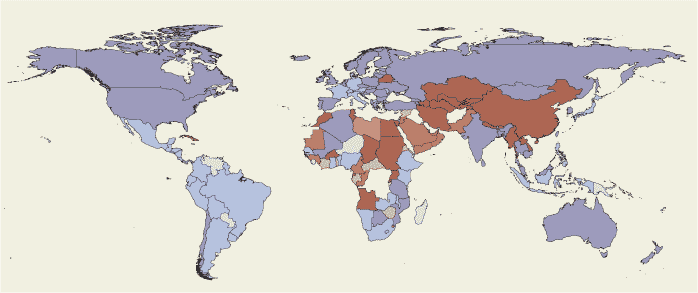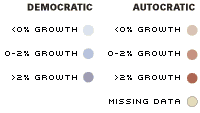Which Came First–Democracy or Growth?
In today's world, most rich countries are democratic and most dictatorships are poor. In the U.S., democracy goes hand in hand with political institutions that promote economic freedom—an environment characterized by the protection of private property and the ability of individuals to engage in voluntary exchange of goods and services. However, democratic governments, even in rich countries, often enact redistributive policies that encumber economic freedom and are detrimental to growth. Therefore, although most economists agree that economic freedom promotes growth, it is not clear that more political freedom (that is, more democracy or political rights) improves economic performance as well.
Economic growth is primarily a consequence of the accumulation of both physical and human capital. The accumulation of capital is sensitive to the choice of public policies, which, in turn, depend on the political institutions in place. In a classic study, economist Robert Barro explained that democratic institutions provide checks on government power that impose limits on politicians' ability to amass wealth and enact unpopular policies. These constraints, he noted, help improve economic freedom. However, authoritarian governments may also improve economic freedom as a matter of policy without the need of institutional constraints; an example is the rule of Gen. Augusto Pinochet in Chile.
In Barro's study of about 100 countries over the period 1960 to 1990, he found that, at low levels of political freedom, an increase in political rights might enhance economic growth by imposing limits on the government. But he noted that in countries that have already achieved medium levels of democracy, further increases in political rights might retard growth because of growing concerns about income redistribution. After controlling for the presence of free markets, maintenance of the rule of law, education and initial level of income per capita, he concluded that the overall effect of democracy on growth is slightly negative.
Although Barro's study was not the first, his findings spurred a debate among economists that has continued in more recent studies. One view establishes that the adoption of democracy—or, more generally, of political institutions that impose checks and balances on the government—promotes investment in physical and human capital, and, therefore, growth. In contrast, a second view establishes that reaching a certain level of economic development is what allows countries to adopt better institutions. 1
The Institutional View
Economists Daron Acemoglu, Simon Johnson and James Robinson espouse the view that political institutions promote economic performance. These authors found a strong correlation between a measure of protection against government expropriation (to proxy for political institutions) and economic performance (measured by real income per capita) across a large sample of countries. A strong correlation, however, does not necessarily imply that better institutions cause better economic performance, as richer countries may prefer better insti-tutions. To eliminate this feedback effect, Acemoglu and his co-authors studied former European colonies, arguing that current economic performance in these countries depends on existing political institutions that were shaped from the institutions established by European settlers.
The authors characterized two types of colonization strategies that led to different types of political institutions. The first kind was the creation of extractive states. In these colonies, the main goal was to transfer much of the resources of the colony to the European power. Institutions created in the colonies did not provide much protection of private property and did not impose checks against government expropriation. Examples of this case were the Spanish colonies in Mexico and Latin America, and the Belgian colonization of the Congo.
In the second colonization strategy, European settlers migrated in large numbers and created institutions that replicated those in their home country. These institutions emphasized the protection of private property and checks against government expropriation. Examples of this case were Australia, New Zealand, Canada and the United States.
The authors found that the types of institutions adopted in the early stages of either kind of colonization strategy persisted even after the colonies became independent. In extractive states, after achieving independence, the new ruling class may have found it convenient to maintain the existing institutions and use them for their own benefit rather than incur the cost of switching to the alternative model. In the democracy-oriented colonies, since the cost of establishing institutions to impose government checks and secure private property had already been incurred by the colonial power, it was easier for the new independent country to maintain these institutions rather than switch to an extractive model.
The Development View
Economists Edward Glaeser, Rafael La Porta, Florencio Lopez-de-Silanes and Andrei Shleifer defend the second view—that it is economic growth which stimulates democracy or the adoption of better institutions, and not the opposite. They further make the point that the accumulation of human capital is a more important determinant of economic growth than political institutions. They studied a large set of countries in the period 1960 to 2000, classifying them into four categories: autocracies, imperfect autocracies, imperfect democracies and stable (or perfect) democracies. Their measure of democracy captures basic government practices in a combination of institutional and behavioral indicators, such as competitiveness of political participation, openness and competitiveness of executive recruitment, and constraints on the executive.
Glaeser and his co-authors noticed that in 2000 nearly all countries with high levels of education were classified as stable democracies, and nearly all stable democracies were highly educated. In contrast, the economists saw that nearly all countries run by dictators were poorly educated. The authors also noticed that as education levels increased, democracies were more common, albeit many imperfect. In terms of growth, they noticed that most of the poor countries in 1960 were run by dictators. In the four decades that followed, the growth rates among poor countries varied, and some of them managed to get out of poverty while still being run by dictators. This evidence suggests, they argue, that it was not constraints on dictators imposed by institutions that led to growth; rather, dictators chose policies that provided security of property rights to foster investment in physical and human capital, and this led to growth. The authors mention China as an example of a dictatorship in which economic growth has been the result of favorable policy choices and not of institutional constraints on the government.
Indirect Effects of Democracy
Regardless of whether there are any direct effects of democracy on economic growth, the connection between democracy and human capital highlighted by Glaeser and his co-authors has been the subject of more analysis.
Political scientists Matthew Baum and David Lake have found important indirect effects of democracy on growth through its impact on public health and education, two common determinants and proxies of human capital. Both public health and education have large social spillovers even when they are privately provided; therefore, investment in these areas is subject to be influenced by public policy. Baum and Lake found that increasing democracy in poor countries improves the life expectancy of women, whereas increasing democracy in more developed countries improves secondary education enrollment of women. Although the authors did not find any direct effects of democracy on growth, they found that both life expectancy and secondary education have positive effects on gross domestic product per capita growth.
Exporting Democracy
The debate about whether democracy and political institutions generate growth or rather economic development leads countries to adopt better institutions is likely to continue. But, as Barro and others have pointed out, this type of analysis has important implications about the feasibility and desirability of exporting democratic institutions to developing nations, particularly those with low levels of human capital. Initially, it may be easier (or wiser) to promote fundamental features of Western economic systems, such as free markets and the importance of securing private property.
Endnotes
- For a lively discussion between Acemoglu and Glaeser, the two proponents of the alternative views discussed in this article, read also the article in The Wall Street Journal Online from March 13, 2007, listed in the references. [back to text]
References
Acemoglu, Daron; Johnson, Simon; and Robinson, James A. “The Colonial Origins of Comparative Development: An Empirical Investigation.” The American Economic Review, December 2001, Vol. 91, No. 5, pp. 1,369-401.
Barro, Robert J. “Democracy and Growth.” Journal of Economic Growth, March 1996, Vol. 1, No. 1, pp. 1-27.
Baum, Matthew A; and Lake, David A. “The Political Economy of Growth: Democracy and Human Capital.” American Journal of Political Science, April 2003, Vol. 47, No. 2, pp. 333-47.
Glaeser, Edward L.; La Porta, Rafael; Lopez-de-Silanes, Florencio; and Shleifer, Andrei. “Do Institutions Cause Growth?” Journal of Economic Growth, September 2004, Vol. 9, No. 3, pp. 271-303.
The Wall Street Journal Online. “Is Democracy the Best Setting For Strong Economic Growth?” March 13, 2007. See http://online.wsj.com/public/article_print/SB117330214622129995.html (retrieved on Feb. 3, 2008).
Views expressed in Regional Economist are not necessarily those of the St. Louis Fed or Federal Reserve System.
For the latest insights from our economists and other St. Louis Fed experts, visit On the Economy and subscribe.
Email Us



